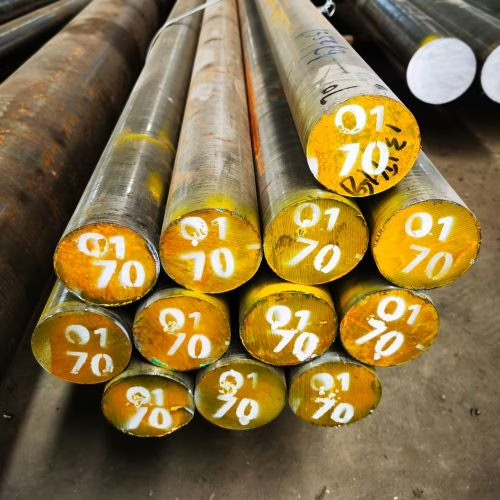
9CrWMn Cold Work Tool Steel
AOBO STEEL – Trusted Global Tool Steel Supplier
9CrWMn is a widely used low-alloy cold work tool steel, designated under China’s national standard (GB/T 1299). Developed from CrWMn steel, its composition has been adjusted to enhance toughness and reduce heat treatment distortion. Its equivalent grades include American AISI/ASTM O1, German DIN 1.2510, and Japanese JIS SKS3.
1. Chemical Composition(GB / T 1299—2000)
| C | Si | Mn | Cr | W | P | S |
| 0.85 ~ 0.95 | ≤0.40 | 0.90 ~ 1.20 | 0.50 ~ 0.80 | 0.50 ~ 0.80 | ≤0.030 | ≤0.030 |
2. Critical Point Temperature of 9CrWMn Steel
| Critical Point | Ac₁ | Acₑₘ | Ar₁ | Ms |
| Temperature/℃ | 750 | 900 | 700 | 205 |
3. Hot Forging Process Specification for 9CrWMn Steel
| Item | Heating Temperature/℃ | Initial Forging Temperature/℃ | Final Forging Temperature/℃ | Cooling Method |
| Steel Ingot | 1150 ~ 1200 | 1100 ~ 1150 | ≥850 | Slow Cooling |
| Steel Billet | 1100 ~ 1150 | 1050 ~ 1100 | ≥850 | Slow Cooling |

Please complete the following contact form to receive the most competitive quotation for 9CrWMn steel.
4. Heat Treatment for 9CrWMn Steel
4.1 Isothermal Annealing Process of 9CrWMn Steel After Forging
| Process | Heating Temperature/℃ | Holding Time/h | Isothermal Temperature/℃ | Isothermal Holding Time/h | Cooling Method | Hardness HBW |
| Isothermal Annealing after forging | 780 ~ 800 | 2 ~ 3 | 670 ~ 720 | 2 ~ 3 | Furnace cool to below 550℃, then air cool | 197 ~ 241 |
4.2 Quenching
① Recommended Quenching Specification for 9CrWMn Steel
| Preheat Temperature/℃ | Heating Temperature/℃ | Cooling Medium | Medium Temperature/℃ | Cool to | Hardness HRC |
| 650 | 820 ~ 840 | Oil | 20 ~ 60 | Oil temperature | 64 ~ 66 |
② Isothermal Quenching Process for 9CrWMn Steel
| Heating Temperature/℃ | Isothermal Temperature/℃ | Isothermal Time/h | Quenching Microstructure |
| 800 ~ 840 | 260 ~ 300 | ≤1 | The matrix is martensite + retained austenite + residual carbides, with a suitable amount of lower bainite distributed on the high-strength martensite matrix. |
4.3 Super-fining Treatment Process for 9CrWMn Steel
The purpose of ultra-fine processing is to obtain ultra-fine carbides and refined grains, hence it is also known as the dual-refining process. This process has been widely adopted in the mold manufacturing industry, significantly extending mold service life.
| Process Stage | Solution Quenching | Final Treatment |
| Process Parameters | The temperature is 1050°C, oil cooling or isothermal treatment at about 300°C, and the tempering temperature is 700~720 °C. | Quenching temperature is 800 ~ 820°C (should be 20 ~ 40°C lower than the conventional quenching temperature). |
4.4 Tempering
① Recommended Tempering Specification for 9CrWMn Steel
| Heating Temperature/℃ | Heating Medium | Cooling Medium | Hardness HRC |
| 160 ~ 180 | Oil | Air | 61 |
| 170 ~ 230 | Oil | Air | 60 ~ 62 |
| 230 ~ 275 | Oil or alkaline water | Air | 56 ~ 60 |
② Relationship between Tempering Temperature and Hardness of 9CrWMn Steel
| Tempering Temperature/℃ | 100 | 200 | 300 | 400 | 500 | 550 | 600 | 650 |
| Hardness HRC | 62 | 60 | 56 | 52 | 47 | 43 | 39 | 35 |
Note: Quenched in oil at 830°C, then tempered for 2 hours.
5. Mechanical Properties
9CrWMn steel is a low-alloy cold-work tool steel with high hardenability. The carbides formed by the W element constitute the hardening phase in the steel, resulting in high hardness and wear resistance after quenching and low-temperature tempering, while maintaining good toughness. This steel exhibits maximum bending strength and toughness when quenched at 800°C. Impact toughness reaches its lowest value when tempered around 300°C; therefore, tempering at this temperature should be avoided. The steel is sensitive to the formation of network carbide. Thus, appropriate forging should be performed during machining, and carbide refinement treatment is recommended.
6. Applications
9CrWMn steel exhibits minimal distortion during quenching, particularly after undergoing carbide refinement treatment, and possesses high comprehensive mechanical properties. It is primarily used for manufacturing various gauges, measuring tools, and mold components such as punching dies with large cross-sectional dimensions, complex shapes, and stringent requirements for minimal quenching distortion—applications where carbon tool steel cannot meet the specifications.


Get a Competitive Quote for 9CrWMn Tool Steel
With over 20 years of forging expertise, Aobo Steel is your trusted partner for high-performance 9CrWMn tool steel. We provide not just materials, but solutions. Leverage our deep industry knowledge and reliable supply chain for your project’s success.
✉ Contact us by filling out the form below.
